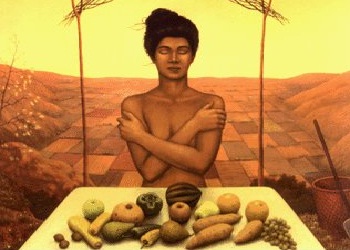On a recent trip to Hawksmoor Air Street we were overjoyed to find a dish called Jansson’s Temptation on the menu, previously spotted in the Moomin Cookbook. But as it turns out, this Swedish version of potato gratin, perfectly suited to a cold, dark winter’s night, is unrelated to Tove Jansson, illustrator of the Moomin cartoons. This did make us start to wonder about the association between food and literature; as it turns out, food is frequently used in a book's most poignant scenes or to define characters.
In New York Days, New York Nights, Stephen Brook uses chocolate to talk about the rise in consumerism in the Big Apple. “New York strews in your path every dream of gratification. Chocolates offer an instantaneous rapture which lingers lovingly on the tastebuds. The vogue for handmade chocolates, and the passion with which they’re devoured, became for me a trivial but potent symbol of the avidity with which New Yorkers consume culture. Restaurants are elevated to gastronomic aristocracy by such reviewers as Mimi Sheraton and Seymour Britchky, and then mobbed for a month until a new prince is born.” Brook wrote this book in 1984, and it couldn’t ring truer almost 30 years later in London. Discerning chocolate lovers will like luxury retailers Rococo Chocolates.
In The Lion, the Witch and the Wardrobe, the Queen of Narnia successfully bribes Edmund with Turkish Delight to squeeze information out of him. The power of this confectionery seems to have an almost hypnotic effect on the boy. “Each piece was sweet and light to the very centre and Edmund had never tasted anything more delicious. He was quite warm now, and very comfortable”. Turkish in Green Lanes and Turnpike Lane sell the sweets, or head to Taste of Turkey at Borough Market where they have 22 different flavours.
In Brett Easton Ellis’ gruesome American Psycho, Patrick Bateman’s matter-of-fact reviews of albums give away his cold, clinical approach to the world. His descriptions of food also reveal his obsession with status. Here he dissects a dish at fictitious restaurant Luke: “Typically the plate is massive, white porcelain; two pieces of blackened yellowtail sashimi with ginger lie in the middle, surrounded by tiny dots of wasabi, which is circled by a minuscule amount of hijiki, and on top of the plate sits one lone baby prawn; another one, even smaller, lies curled on the bottom, which confuses me since I thought this was primarily a Chinese restaurant”. In 2010 members’ club and restaurant Dorsia opened in London, named after the venue of the same name in the book. It’s since closed down, but instead you can head to Hakkasan or Nobu for modern Asian cuisine and narcissism.
The late Nora Ephron had no time for restraint, in particular when it came to diets. In her 2010 collection of essays I Remember Nothing, she has a rant about people who discard egg yolks from omelettes for being high in cholesterol. “Every time I’m forced to watch them [friends] eat egg-white omelettes, I feel bad for them. In the first place, egg-white omelettes are tasteless. In the second place, the people who eat them think they are doing something virtuous when they are instead misinformed”. She then goes on to say that omelettes are not made by taking out yolks, but rather by putting in additional ones, and her recipe for egg salad has eighteen eggs, six of them minus whites, which should be sent “to friends in California who persist in thinking that egg whites matter in some way”. Ephron would approve of the Wolseley. with its range of fried, poached, scrambled or boiled eggs, eggs Benedict and caviar omelettes.
There are many evocative passages in The Little Prince, and only Antoine De Saint-Exupery could make water sound romantic. “It was as sweet as some special festival treat. This water was indeed a different thing from ordinary nourishment. Its sweetness was born of the walk under the stars, the song of the pulley, the effort of my arms. It was good for the heart, like a present”. Sadly, we are not yet aware of anywhere that sells water quite this heartwarming, but it probably depends on who is offering it to you, and how thirsty you are.
Books about food you can read like novels
Nigel Slater’s Toast tells the story of the food writer’s childhood by reminiscing about the dishes he grew up with.
Aphrodite (pictured) by Isabella Allende is a memoir and recipe book rolled into one. Allende’s sensual, evocative style is second to none, and this is one of the finest books in existence that combines the two subjects.
The Flavour Thesaurus by Niki Segnit is an encyclopaedia, but the author’s anecdotes are as pleasurable to read as a work of fiction.
Agnes Jekyll’s 1922 work A Little Dinner Before the Play has advice on serving the right food for any occasion, from “luncheon for a motor excursion in winter” to the situation in the title. It's witty, detailed and full of clever observations, like presenting wholesome food on a brightly coloured tray with flowers to cheer up an invalid.
Food and literature
Poignant food scenes in literature and where to recreate them

Published Mar 4, 2013
